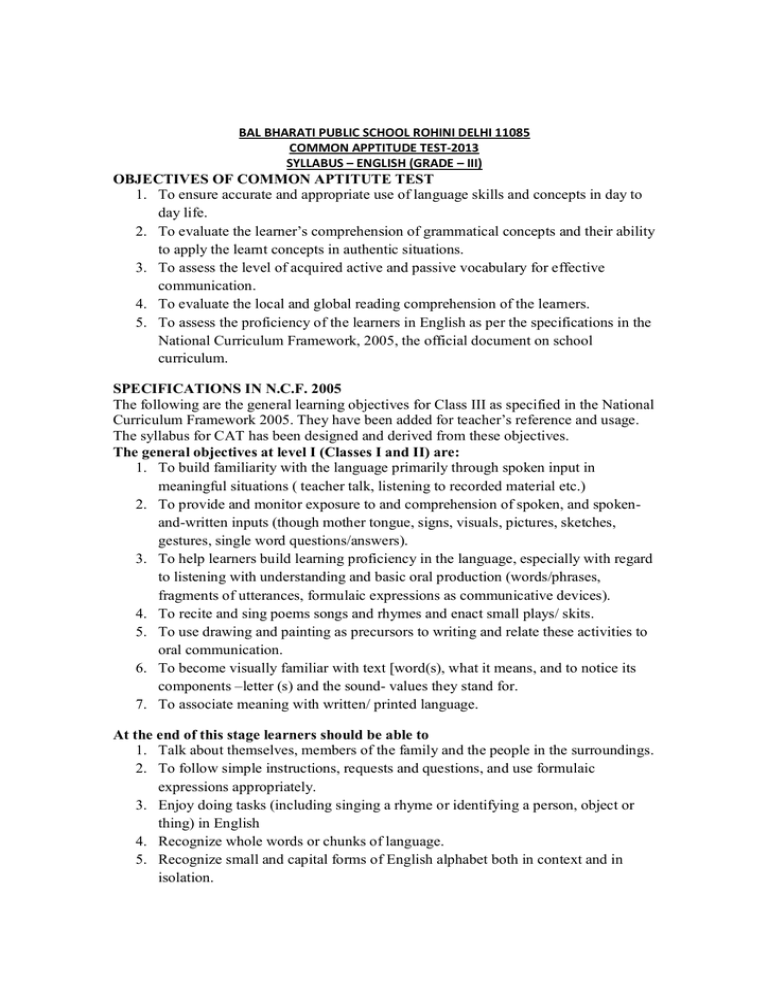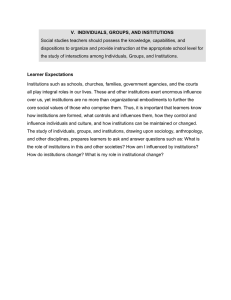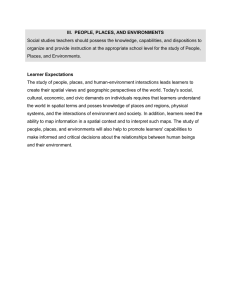BAL BHARATI PUBLIC SCHOOL ROHINI DELHI 11085 COMMON APPTITUDE TEST-2013
advertisement

BAL BHARATI PUBLIC SCHOOL ROHINI DELHI 11085 COMMON APPTITUDE TEST-2013 SYLLABUS – ENGLISH (GRADE – III) OBJECTIVES OF COMMON APTITUTE TEST 1. To ensure accurate and appropriate use of language skills and concepts in day to day life. 2. To evaluate the learner’s comprehension of grammatical concepts and their ability to apply the learnt concepts in authentic situations. 3. To assess the level of acquired active and passive vocabulary for effective communication. 4. To evaluate the local and global reading comprehension of the learners. 5. To assess the proficiency of the learners in English as per the specifications in the National Curriculum Framework, 2005, the official document on school curriculum. SPECIFICATIONS IN N.C.F. 2005 The following are the general learning objectives for Class III as specified in the National Curriculum Framework 2005. They have been added for teacher’s reference and usage. The syllabus for CAT has been designed and derived from these objectives. The general objectives at level I (Classes I and II) are: 1. To build familiarity with the language primarily through spoken input in meaningful situations ( teacher talk, listening to recorded material etc.) 2. To provide and monitor exposure to and comprehension of spoken, and spokenand-written inputs (though mother tongue, signs, visuals, pictures, sketches, gestures, single word questions/answers). 3. To help learners build learning proficiency in the language, especially with regard to listening with understanding and basic oral production (words/phrases, fragments of utterances, formulaic expressions as communicative devices). 4. To recite and sing poems songs and rhymes and enact small plays/ skits. 5. To use drawing and painting as precursors to writing and relate these activities to oral communication. 6. To become visually familiar with text [word(s), what it means, and to notice its components –letter (s) and the sound- values they stand for. 7. To associate meaning with written/ printed language. At the end of this stage learners should be able to 1. Talk about themselves, members of the family and the people in the surroundings. 2. To follow simple instructions, requests and questions, and use formulaic expressions appropriately. 3. Enjoy doing tasks (including singing a rhyme or identifying a person, object or thing) in English 4. Recognize whole words or chunks of language. 5. Recognize small and capital forms of English alphabet both in context and in isolation. 6. Read simple words/small sentences with the help of pictures and understand them. 7. Write simple words/phrases/short sentences. SYLLABUS FOR CAT ENGLISH (CLASS III) 1. Reading comprehension- 1 passage of 75-100 total words length which can be factual or descriptive. 2. Grammar topics: a. Noun- Common, Proper b. Pronouns – I, He, She, They, It c. Simple Present Tense d. Simple Past tense e. Adjectives (Describing words) f. Prepositions – is, on, under, near, behind, below, above g. Punctuation- ‘.’, ‘,’, ‘?’, Capital Letters. h. Verbs 3. Vocabulary: a. Antonyms b. Genders c. Homophones d. Missing/jumbled letters e. One/many 4. Editing and Error Correction a. Words/spellings b. Sentences BAL BHARATI PUBLIC SCHOOL, ROHINI, DELHI- 110034. COMMON APTITUDE TEST -2013 SYLLABUS- ENGLISH (GRADE-5) OBJECTIVES OF COMMON APTITUDE TEST: 1. To ensure accurate and appropriate use of language skills and concepts in day to day life 2. To evaluate the learner’s comprehension of grammatical concepts and their ability to apply the learned concepts in authentic situations. 3. To assess the level of acquired active and passive vocabulary for effective communication. 4. To evaluate the learner’s use of language for deriving inferences from texts, using structures to express opinion. 5. To use language as a tool to write long or short compositions for creative expression. 6. To assess the proficiency of learners in English as per the specifications in the National Curriculum Framework, 2005, the official document on curriculum. SPECIFICATIONS IN N.C.F. 2005: The following are the general learning objectives for class V as specified in National Curriculum Framework, 2005. They have been added for teacher’s reference and usage. The syllabus for CAT has been designed and derived from these objectives. The general objectives at level II (Classes III, IV and V) are To provide print rich environment to relate oracy with literacy. To build on learners’ readiness for reading and writing. To promote learners’ conceptualization of printed texts in terms of headings, paragraphs and horizontal lines. To enrich learners vocabulary mainly through telling, retelling and reading aloud of stories/ folktales in English. To use appropriate spoken and written language in meaningful contexts/ situations. To give them an opportunity to listen to sounds/ sound techniques and appreciate actions and therby provide understanding of the language. To familiarize learners with the basic process of writing At the end of this stage, learners should be able to To narrate his/ her experiences Exchange his/ her ideas with the peers. Carry out a brief conversation involving seeking/ giving information. Enjoy reading a story, poem, a short write up, a notice, a poster etc Take dictation of simple sentences and to practice copy writing from the blackboard and textbooks and to use common punctuation marks. Write a short description of a person, thing or place- prepare a notice, or write a message for someone. Write a short composition based on pictures Take part in group activity, role lay and dramatization SYLLABUS FOR CAT, ENGLISH (CLASS V) . 1. Reading comprehension- 2 passages of 150-200 each words length One passage which can be factual or descriptive. Another literary passage e.g. extract from fiction, drama, poetry, essay or biography. 2. Grammar topics. 2.1 Nouns- a) Number b) Gender c) Types of Noun- Common, Proper and Collective. 2.2 Pronouns- I, me, you, we, they, he, she, it, him, her, them, their 2.3 Adjectives 2.4 Degrees of comparison 2.5 Verbs 2.6 Subject- Verb agreement 2.7 Sentence- Subject & Predicate 2.8 Kinds of Sentence 2.9 Simple & Continuous Tenses 2.10 Conjunctions – and, but, or, because 2.11 Prepositions- in, on, into, to, above, below, under, near, behind, beside, between, among 2.12 Articles- a, an, the 3. Vocabulary- 3.1 Spell check 3.2 Jumbled words 3.3 Synonyms 3.4 Antonyms 3.5 Homophones 4. Editing extracts- Correcting words/ sentences 5. Writing skills Sequencing of recipe/ story Guided Paragraph writing





